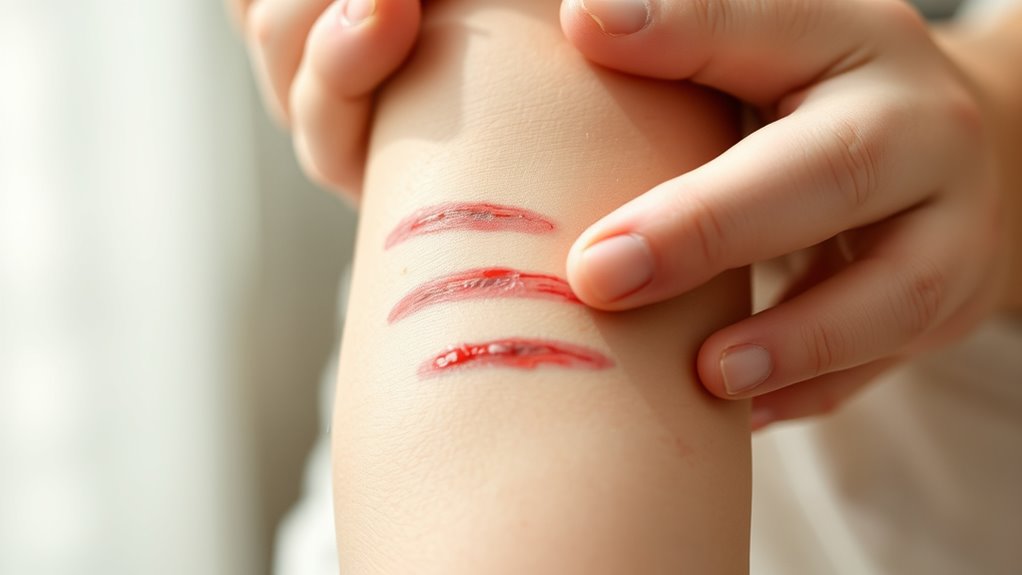If you’ve been bitten or scratched, start by washing the wound thoroughly with soap and clean water to remove dirt and bacteria. Apply an antiseptic and cover it with a sterile bandage to prevent infection. Keep an eye out for signs of infection like redness, swelling, or pus, and seek medical help if symptoms worsen. Make sure your tetanus vaccinations are up to date. To learn more about protecting yourself and ensuring proper care, keep exploring these essential steps.
Key Takeaways
- Clean the wound thoroughly with soap and water to reduce infection risk.
- Cover with a sterile bandage and monitor for signs of infection or complications.
- Seek medical attention for deep wounds, signs of infection, or if tetanus vaccination is overdue.
- Be cautious of zoonotic disease transmission from animal bites or scratches; consult healthcare providers if needed.
- Maintain pet health and environment safety to prevent bites, scratches, and associated infections.

Bites and scratches can happen unexpectedly, but knowing how to manage them promptly can prevent infections and complications. When you’re faced with a bite or scratch, your first priority is to stay calm. Immediate action can markedly reduce the risk of infection and zoonotic disease transmission. Start by thoroughly washing the wound with soap and clean water. This basic step is essential in pet first aid because it helps remove dirt, bacteria, and other potential contaminants. Avoid scrubbing too hard, as that can worsen tissue damage, but make sure you clean the area well. After washing, pat the wound dry with a clean towel or gauze. Applying an antiseptic ointment or solution can further reduce bacteria, helping to prevent infection. Cover the wound with a sterile bandage to keep it protected from dirt and bacteria, especially if you’re going to be outdoors or in dirty environments.
Monitoring the wound is critical. Keep an eye on it for signs of infection, such as increased redness, swelling, warmth, pus, or persistent pain. If any of these signs develop, seek medical attention promptly. Don’t ignore symptoms; infections can develop quickly, and early intervention can prevent more serious complications. It’s also important to consider tetanus vaccination status. If your tetanus shot isn’t up to date or if the wound is deep, consult a healthcare professional for a booster shot or further treatment.
In terms of zoonotic disease prevention, understanding the risks associated with animal bites and scratches is essential. Many animals carry bacteria or parasites that can be transmitted to humans. For example, scratches from cats can introduce Bartonella bacteria, leading to cat scratch disease, while dog bites might transmit rabies if the animal is infected. Always seek medical advice if bitten or scratched by an unfamiliar or wild animal, or if the animal’s health status is uncertain. Avoid handling animals that appear sick or aggressive, and teach children about safe interactions with pets. Proper pet first aid knowledge helps you respond immediately, reducing the chance of zoonotic diseases taking hold. Additionally, understanding the importance of unique and wicked planters can help you create a safe environment that minimizes risks associated with outdoor pets and gardening activities.
Finally, if the bite or scratch is from your pet, make sure they are healthy and up to date on vaccinations. Regular veterinary checkups can prevent many issues that lead to bites or scratches. Remember, prompt wound care, cleanliness, and awareness of zoonotic disease risks are your best defenses in managing bites and scratches effectively. Acting quickly and correctly can make a profound difference in recovery and health outcomes.
Frequently Asked Questions
When Should I See a Doctor for a Bite or Scratch?
You should see a doctor if a bite or scratch becomes red, swollen, or painful, or if it doesn’t heal in a few days. Seek care immediately if you notice signs of infection or allergic reactions, like difficulty breathing or swelling. Also, get checked if your tetanus vaccination isn’t up-to-date. Prompt medical attention guarantees proper cleaning, possible antibiotics, and vaccines to prevent complications.
Can Animals Transmit Rabies Through Bites or Scratches?
Yes, animals can transmit rabies through bites, and it’s no joke—your furry friend or wild encounter could be a tiny virus delivery service. Rabies transmission happens mainly via animal bites, especially from unvaccinated or wild animals. Scratches are less risky but still worth noting if contaminated with saliva. Always seek medical advice after animal bites, because ignoring rabies transmission risks turning your life into a horror story.
How Can I Prevent Bites and Scratches From Pets?
To prevent bites and scratches from your pet, observe their behavior and respect their boundaries. Keep an eye on signs of discomfort or stress, and avoid rough play. Establish consistent grooming routines to keep your pet calm and comfortable, reducing the likelihood of aggressive reactions. Always handle your pet gently, and reward good behavior. Training and socialization also help your pet feel secure, decreasing the chances of biting or scratching.
Are There Home Remedies for Minor Bites and Scratches?
Sure, you can try natural remedies for minor bites and scratches—because who needs a doctor when you have herbal treatments? Apply honey or aloe vera to soothe the skin, and use tea tree oil for its antibacterial properties. Keep the wound clean and dry, and consider over-the-counter remedies if needed. Just remember, even herbal treatments can’t replace professional care if the injury worsens—so don’t get too herbal-happy!
What Signs Indicate an Infection From a Bite or Scratch?
If you notice signs of infection from a bite or scratch, watch for increasing redness, swelling, warmth, or pus. You might also experience persistent pain, a fever, or swollen lymph nodes near the area. These symptoms indicate that infection symptoms to watch for are worsening, and you should seek medical attention promptly. Quick action helps prevent complications and guarantees proper treatment.
Conclusion
Remember, managing bites and scratches is like tending to a delicate garden—you need patience, care, and prompt action. Clean the wound gently, watch for signs of infection, and seek medical help if needed. Treating bites and scratches quickly prevents them from becoming a storm of trouble. By staying vigilant, you’re the gardener protecting your health, ensuring your well-being blooms beautifully despite any unexpected thorns along the way.









